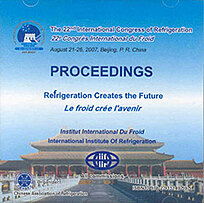
Résumé
Present international standards for thermal comfort such as ASHRAE Standard 55 and ISO 7730 were developed based on the lab-based methods. It is not appropriate to estimate the occupants' thermal comfort in natural ventilated buildings. In order to understand the condition of the indoor thermal environment and human thermal comfort in hot-humid climate zone, especially the summer case, a field study had been carried out from July to September, 2006. This study is based on the objective physical parameters measurement, such as dry/wet bulb temperature, air velocity etc and subjective thermal comfort questionnaire surveys according to the ASHRAE standard in natural ventilated classroom in Chongqing, a typical region of hot-humid climate in southwest China. The relationship between PMV (predict mean vote), AMV (actual mean vote) and indoor air temperature is shown. Also, empirical equations of PMV and AMV are obtained. Furthermore, this paper discussed the neutral temperature, preferred temperature and acceptable temperature respectively. It is need to revise these international standards to estimate occupants' thermal comfort in natural ventilated buildings.
Documents disponibles
Format PDF
Pages : ICR07-E1-1576
Disponible
Prix public
20 €
Prix membre*
Gratuit
* meilleur tarif applicable selon le type d'adhésion (voir le détail des avantages des adhésions individuelles et collectives)
Détails
- Titre original : Investigation on natural ventilated classroom thermal comfort in hot-humid climate.
- Identifiant de la fiche : 2008-0359
- Langues : Anglais
- Source : ICR 2007. Refrigeration Creates the Future. Proceedings of the 22nd IIR International Congress of Refrigeration.
- Date d'édition : 21/08/2007
Liens
Voir d'autres communications du même compte rendu (839)
Voir le compte rendu de la conférence
Indexation
- Thèmes : Conditionnement d'air pour le confort
- Mots-clés : Climat humide; Ventilation naturelle; École; Conditionnement d'air; Climat chaud
-
Using wind as an approach natural ventilation i...
- Auteurs : KARIMZADEH A., SHAHRIARI S., SHAHRIARI S. K. A.
- Date : 16/06/2013
- Langues : Anglais
- Source : Clima 2013. 11th REHVA World Congress and 8th International Conference on Indoor Air Quality, Ventilation and Energy Conservation in Buildings.
- Formats : PDF
Voir la fiche
-
Computational analysis of cross ventilation for...
- Auteurs : CHANG C. Y., CHAN Y-C.
- Date : 09/07/2018
- Langues : Anglais
- Source : 2018 Purdue Conferences. 5th International High Performance Buildings Conference at Purdue.
- Formats : PDF
Voir la fiche
-
Thermal comfort and energy saving potential of ...
- Auteurs : HUANG K. T., HWANG R. L.
- Date : 16/06/2013
- Langues : Anglais
- Source : Clima 2013. 11th REHVA World Congress and 8th International Conference on Indoor Air Quality, Ventilation and Energy Conservation in Buildings.
- Formats : PDF
Voir la fiche
-
Study on cross-ventilation with radiation panel...
- Auteurs : SONG D., KATO S., KIM T., et al.
- Date : 2002
- Langues : Anglais
- Source : ASHRAE Transactions. 2002 annual Meeting, Honolulu, Hawaii. Volume 108, part 2 + CD-ROM.
Voir la fiche
-
Thermal environment of the low-exergy system co...
- Auteurs : TAKAHASHI I., TSUJII Y., ITOU N.
- Date : 16/06/2013
- Langues : Anglais
- Source : Clima 2013. 11th REHVA World Congress and 8th International Conference on Indoor Air Quality, Ventilation and Energy Conservation in Buildings.
- Formats : PDF
Voir la fiche
